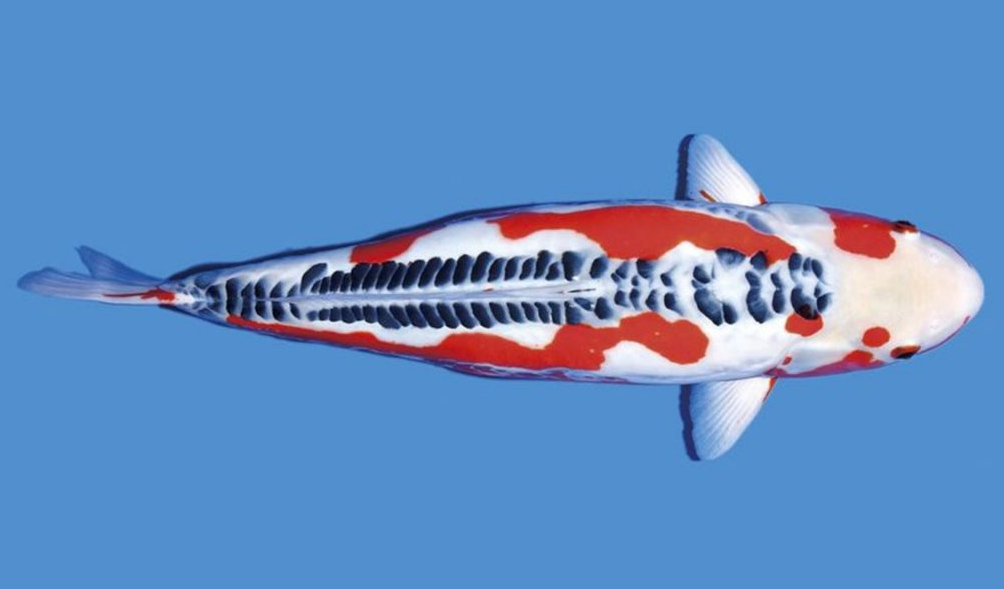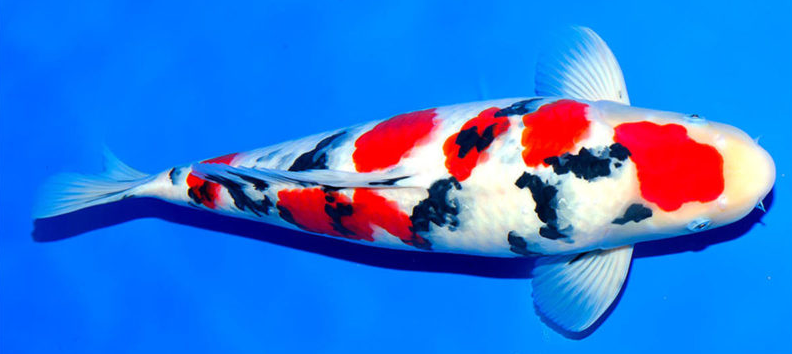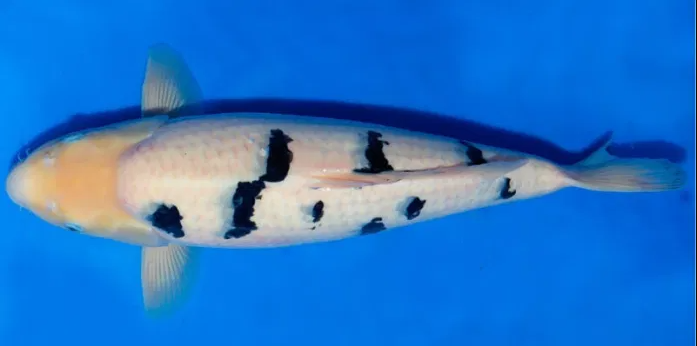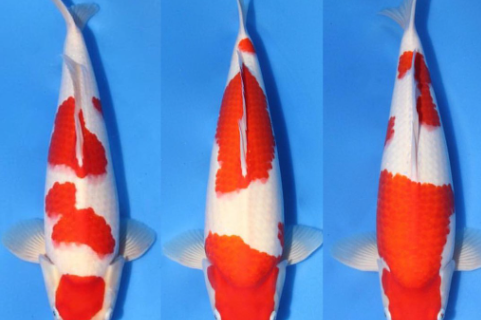Koi fish origins from Japan and become one of the symbols of love and friendship in Japan. The name of the koi fish is taken from the word ‘Nishiki‘ in Japanese, which literally means “brocaded carp” or something beautiful or graceful. Presently, most people in the world keeping koi fish as a hobby. People are attracted to the peaceful and friendly characteristics of koi.
More than 100 types of koi fish have been recognized till today. The varieties have been identified based on colors, scales, and patterns. Commonly, Koi fish are found in white, red, black, blue, yellow, and cream colors.
Koi fish is one that you’ll see commonly in aquariums or in outdoor pond. The colors and patterns they owns are giving life to any aquarium or pond that they are in. You probably want to know more about some various types of Koi fish. If so, the read this article ahead!

Kohaku
Kohaku is a type of koi that has a white base color with a red or orange pattern on its body. It is well-known as the king of Koi fish. This Koi type with white and red color is one of the main types that have been around for hundreds of years.
Almost all ornamental fish hobbyists are breeding this types of Koi, both beginners and experts. This koi has a simple pattern that makes it look elegant and pleasing to the eye.
Based on the location of the red pattern, Kohaku is literally divided into several types.
- Menkaburi Kohaku is a type of kohaku that has a red pattern covering the head like a hood (hood = veil or head covering).
- Kuchibeni Kohaku is a type of kohaku that has a red pattern on the lips like lipstick.
- Inazuma Kohaku is a type of kohaku that has a red color with a zig zag pattern like a lightning strike and connects.
- Maruten Kohaku is a type of kohaku that has a red pattern on the crown of the head and the body also has a red pattern (maruten = crown).
- Straight Hi Kohaku is a type of kohaku that has one red pattern that is straight and connecting.
- The Tancho Kohaku is a type of kohaku that has a single red pattern on the crown but with a pure white body.
- Doitsu Kohaku is a type of kohaku but without scales on his body.
- Ginrin Kohaku is a type of kohaku with shiny silver-like scales.
The types of kohaku above are distinguished based on the distribution of the red pattern on the body and the scale factor. The above classification does not determine the quality of the kohaku itself, because each type can have low or high quality.
Taisho Sanke
One type of Koi fish that has red and black colors on a white base is known as Taisho Sanshoku or popularly known as ‘Sanke’. The word ‘Sanshoku’ in Japanese means ‘3 colors’, and ‘Taisho’ is taken from the name of the Emperor of Japan when this Koi became popular, namely in the Taisho Era (1912-1926). Sanke is one of 13 varieties of koi that has a unique character, which are:
- Red pattern (hi) on Sanke, which is the same as on Kohaku. So to judge the quality of the red pattern on Sanke follow the rules on Kohaku.
- Black Color Pattern (sumi) is minor, relatively less in proportion than the red color. Usually in the form of spots or if it forms a pattern then it is not as wide as the red pattern. Sumi that is thick, shiny and on white or known as Tsubo Sumi is preferred. While the black on red is called Kasane Sumi.
- White Color Like a painting, white color on Sanke as the basis. The white color that is as white as snow (snow white) is one of the dominant factors to determine the quality of Sanke. In various Koi contests, Sanke with white as white as snow, often emerges as the winner. It is not easy to find a Sanke with a white color that is as white as snow, but this is the main consideration in choosing a quality of Sanke.
Color combination, when the three colors blend in from the head to the tail, it will look like a Kohaku pattern with black as an accent or balance. For example, if there is a red pattern that extends to the left side of the Koi’s back area, then black is the counterbalance. Sometimes you need a black pattern like the footprints that make Sanke look more elegant.

Showa
This amazing breed of Showa koi fish first appeared in 1927, but the colors did not reach the perfection it is today before 1965. After 36 years a breeder named Tomiji Kobayashi finally bred the koi that set the standard for today’s Showa koi variety.
The variety of Showa koi fish becomes even more beautiful when breeders cross Showa koi with Sanke and Kohaku to improve the color and markings that distinguish them from other koi varieties. Unlike the Sanke, which is often mistaken for a Showa koi, the Showa koi variety has a black base with white and red markings. The black should be dark and glossy and no brown spots appear. White markings provide a dramatic contrast to Showa’s solid black base color and should be pure white.
Although the marking color of the Showa koi fish is the same as the Sanke, the marking pattern is very different. The biggest difference in the markings of Showa koi and Sanke koi is that Showa have red and white markings while Sanke have black and red markings. Showa koi have large white markings with clean edges that meet a red or black base color. Often the black base color appears to ‘wrap’ the koi which is the hallmark of Showa koi.
Tancho
Tancho is a type of koi fish that only has a Hi (red) color and forms a round pattern (circle) right on the head. A good tancho, there is no other pattern or color on the body, although only one scale. If there is a Koi that has a circle pattern right on its head like Tancho but still has several other patterns and colors, then it is not called Tancho, but “Maruten”.
The most popular type of Tancho is the Tancho Kohaku. Meanwhile, other types of Tancho are also found in several varieties, including Tancho Sanke, Tancho Showa etc
Usturimono
Usturimono This type of koi fish usturimono consists of 3 koi of two different colors. Shiro Utsuri, the black and white koi fish, is the most popular followed by the red and black Hi Utsuri. And the yellow and black Ki Utsuri.
Bekko
Bekko Koi Fish is a koi fish with a black pattern. There are three types of Bekko Koi, which are: Koi Shiro Bekko, Koi Ki Bekko, and Koi Fish Aka Bekko.
-
Koi Shiro Bekko
Shiro bekko koi fish have a white base color with a small black pattern. The black pattern (Sumi) on the Shiro Bekko koi fish must be balanced and have sharp edges (Kiwa). The types of koi fish Shiro Utsuri and Shiro Bekko have similarities, because of the same color pattern.
The difference between the types of koi fish Shiro Bekko and Shiro Utsuri is that Shiro Utsuri has a larger black color pattern while Shiro Bekko only has a little black.
-
Koi Ki Bekko
Koi fish ki bekko is a type of koi fish that has a yellow base color with black on top. Like the Shiro Bekko koi fish, but the base color is bright yellow. The black pattern (Sumi) on the Ki Bekko koi fish must be balanced and have sharp edges (Kiwa). This type of koi fish is difficult to obtain compared to other types.
-
Koi Fish Aka Bekko
Koi fish aka bekko is a type of koi fish that has a red base color with small black patterns on it. The black color has a beautiful and attractive spot.

Asagi
Asagi has a very wanderful mix of blue and red. The characteristics of Asagi can be distinguished, namely on the back there is an arrangement of scales that resemble a blue or bluish net or mesh.
The quality of Asagi is determined by the following:
-
Head Section
Part ii is the most important thing that must be considered in choosing Asagi, quality Asagi, namely on the head it looks clean, milky white and there are no spots or color spots (spots). Then on both cheeks and gill covers there is a bright red color.
-
Back
Asagi’s back looked like it was wrapped in a blue or bluish net. The pattern of the nets on a good Asagi is even and the blue color is clear (not faint).
- Pectoral Fins
On the pectoral fins of Asagi there is a bright red color. The composition of the red color and the pattern in this section is symmetrical, between the left and right fins. This red pattern at the base of the Asagi fin is known as Motoaka or Sushi Fin.
-
Stomach part
Check the abdomen to see the spread of red color from the chest that extends to the anus.
Shusui
One of the most expensive types of koi fish is the Shusui koi. It is cross-breeding of the asagi koi and the scale less koi or koi doitsu. Which managed to give birth to new koi called shusui koi fish.
A good shusui koi has a light blue head and sky blue back scales. Also has a color that is not opaque. In addition, good shusui koi on the gill covers, on the abdomen, and at the base of the pectoral fins should have a bright red color pattern.
One more thing, namely, the blue color on the back of a good shusui koi is to have a tight arrangement and connect without breaking. The scales that are located between the upper back and abdominal scales are called mudagoke scales or redundant scales, which means scales that are not useful. Because the presence of these scales actually makes the impression of the koi motif untidy, usually there are only a few of these scales.
Koromo
Koromo is a type of koi fish that includes several varieties namely goromo, goshiki, and koromo. The most popular is the Ai Goromo which is similar to the Kohaku, but whose red scales are coated in black.
Goshiki
Goshiki is a type of koi that belongs to the Kawarimono variety. From its name, Goshiki , consists of 2 words namely ‘Go’ in Japanese means ‘five’ and ‘Shiki’ which means ‘color’. So Go shiki is a koi that has a combination of 5 colors, namely: Blue, Dark Blue, Red, Black and White.
Overall, Goshiki’s appearance is purplish, with bright red colors forming a Kohaku-like pattern. Goshiki colors will perform best in warm temperatures and will fade at lower temperatures
